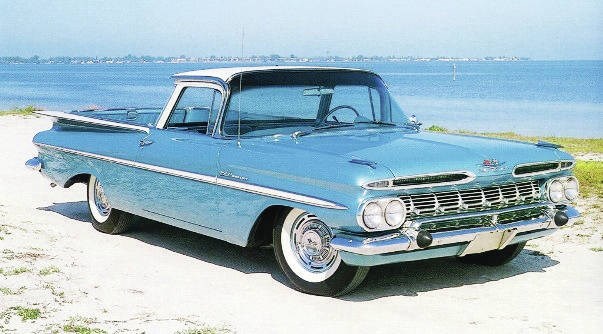When the Ford Motor Co. introduced its 1957 Ranchero sedan-pickup it added a new car-like dimension to American light duty trucks. To create this novel approach to a light commercial vehicle Ford removed the rear part of a two-door Ford station wagon and replaced it with a smoothly integrated utility box. It combined cargo carrying versatility with car-like driving characteristics. A bonus was access to virtually all car luxury options and conveniences.
The target market was people like gentleman farmers and field supervisors who wanted a little more glamour and luxury in their everyday driving.
Not to be outdone, Chevrolet’s response was the 1959 El Camino (Spanish for “the road’) sedan-pickup based on the Chevrolet station wagon. This gave it those “bat wing” rear fins, slim pillars, large wraparound windshield and full rear window for 360 degree visibility. The bench seat accommodated three passengers.
The El Camino had the Chevrolet’s X-braced frame, and a steel-floored cargo box with 33 cubic feet volume. Suspension was by coil springs all around and payload ranged up to 522 kg (1,150 lb) depending on suspension and powertrain.
The standard engine was the 3.8 litre (235 cu in.) overhead valve, 135 horsepower inline six. Options were a 4.6 litre (283 cu in.) V-8 in two horsepowers. Transmissions were a column shifted three-speed manual, available with overdrive, a two-speed “Powerglide” or “Turboglide” automatic. A floor-shifted, four-speed manual was available with higher output engines.
The El Camino carried into 1960 largely unchanged except that the fins were flattened for a less flamboyant appearance.
Surprisingly the El Camino left the scene after only two model years. There were a couple of reasons. The first was that the two-door, full size Chevrolet wagon on which it was based was discontinued; the second was that sales had dropped from over 22,000 1959s to about 14,000 1960s.
But the El Camino wasn’t gone forever; it had only taken a three year hiatus. When it reappeared in 1964 it was based on the mid-sized Chevelle two-door wagon. Although now an intermediate, its box was bigger than the original in both depth and length.
The Chevelle proved to be a good choice because the industry was on the verge of the big-engine-in-a-light-car “muscle car” craze kicked off by the 1964 Pontiac GTO. Chevrolet chose the Chevelle as its entry in the performance race, and since the El Camino was Chevelle-based it could join in too.
Almost all options available for the Chevelle SS396 muscle car could be had by El Camino buyers seeking higher performance. In addition to the country squire and horsy set it attract a new clientele, one looking for speed not cargo space.
By 1968 Chevrolet was emphasizing the sporty aspect by offering the El Camino SS 396 with the 396 cu in. (6.5 litre) V-8. The market was clearly ready because 1968 El Camino sales rose 20 percent to almost 42,000, the highest so far.
In 1969 sales increased again, so Chevrolet responded for 1970 with an even bigger optional engine, the tire-smoking El Camino SS 454 with 454 cubic inches (7.4 litres). Ford had also been active with the muscle, culminating in its 429 cubic inch (seven litre) Cobra Jet V-8 for the 1970 Ranchero GT.
But conditions were about to change. When muscle cars were at their peak, environmental concerns began to emasculate them. With the 1971 models compression ratios began falling in anticipation of the non-leaded gasoline needed for catalytic converters. And emissions hardware was sapping power, gradually killing the muscle car.
But being classed as a truck, the El Camino escaped the worst of the emission controls and carried on with SS models and high performance V-8s for several years as kind of a sleeper vehicle for performance enthusiasts.
In 1971 the El Camino was joined by the corporate clone GMC Sprint, which became the GMC Caballero in 1978. Although competitor Ford Ranchero disappeared in 1979 the El Camino was able to keep interest up with such options as the Royal Knight and Diablo featuring special striping on a black exterior.
Over the years the intermediates grew bigger, and the El Camino along with it. This was addressed in 1978 when the final generation El Camino was based on the smaller Chevrolet Malibu wagon. It was trimmer and lighter with a V-6 engine standard and a V-8 optional.
The El Camino carried on for a few more years, but minivans and sport utilities were gaining popularity. Its last full year was 1987 followed by a few ’88s.
Although the El Camino was always a niche vehicle it still managed a 30 year run with only a short gap. And to prove the concept never dies, Chevrolet introduced an El Camino inspired reincarnation in 2003, the SSR Sport Truck.



